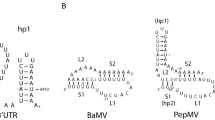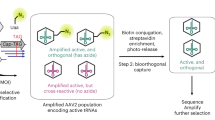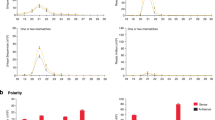Abstract
Although protein synthesis usually terminates when a stop codon is reached along the messenger RNA sequence, there are examples, mainly in viruses, of the stop codon being suppressed by a tRNA species. A strong candidate for this phenomenon occurs in tobacco mosaic virus (TMV) in the form of two proteins (110K and 160K, of molecular weights 110,000 and 160,000, respectively)1, sharing an N-terminus sequence, which are translated in vitro from a purified species of viral RNA. We have investigated the identity of the tRNA responsible for production of the 160K protein and show here that it is one of the tyrosine tRNAs. Another tyrosine tRNA, in which the first base of the anticodon is highly modified, does not act as a suppressor, indicating the possible regulatory function of such modifications.
This is a preview of subscription content, access via your institution
Access options
Subscribe to this journal
Receive 51 print issues and online access
$199.00 per year
only $3.90 per issue
Buy this article
- Purchase on Springer Link
- Instant access to full article PDF
Prices may be subject to local taxes which are calculated during checkout
Similar content being viewed by others
References
Pelham, H. R. B. Nature 272, 469–471 (1978).
Bienz, M. et al. Nucleic Acids Res. 8, 5169–5178 (1980).
Dudler, R. et al. Chromosoma 84, 49–60 (1981).
Vögeli, G. Nucleic Acids Res. 7, 1059–1065 (1979).
Bienz, M. thesis, Univ. Zürich (1981).
Knowland, J. Genetics 78, 383–394 (1974).
Pelham, H. R. B. & Jackson, R. J. Eur. J. Biochem. 67, 247–256 (1976).
Sakai, F. & Takebe, I. Molec. gen. Genet. 118, 93–96 (1972).
Bruening, G. et al. Virology 71, 498–517 (1976).
Morch, M. D. & Benicourt, C. Eur. J. Biochem. 105, 445–451 (1980).
Piper, P. W. et al. Nature 262, 757–761 (1976).
Zimmern, D. Cell 11, 463–482 (1977).
Heckman, J. thesis, Massachusetts Inst. Technol. (1975).
Manley, J. L. J. molec. Biol. 125, 407–432 (1978).
Atkins, J. F. Cell 18, 1119–1131 (1979).
Crick, F. H. C. J. molec. Biol. 19, 548–555 (1966).
Lagerkvist, U. Proc. natn. Acad. Sci. U.S.A. 75, 1759–1762 (1978).
Twardzik, D. R. et al. J. molec. Biol. 57, 231–245 (1971).
White, B. N. et al. J. molec. Biol. 74, 635–651 (1973).
Owenby, R. K. et al. Mechanisms Ageing Dev. 11, 91–103 (1979).
Gauss, D. H. & Sprinzl, M. Nucleic Acids Res. 9, r1–r23 (1981).
Salser, W. et al. Cold Spring Harb. Symp. quant. Biol. 34, 513–520 (1969).
Feinstein, S. I. & Altman, S. Genetics 88, 201–219 (1977).
Bossi, L. & Roth, J. R. Nature 286, 123–127 (1980).
Bienz, M. et al. Nucleic Acids Res. 9, 3835–3850 (1981).
Kohli, J. & Grosjean, H. Molec. gen. Genet. 182, 430–439 (1981).
Weiner, A. M. & Weber, K. Nature new Biol. 234, 206–209 (1971).
Weiner, A. M. & Weber, K. J. molec. Biol. 80, 837–855 (1973).
Hofstetter, H. et al. Biochim. biophys. Acta 374, 238–251 (1974).
Geller, A. I. & Rich. A. Nature 283, 41–46 (1980).
Hosbach, H. A. & Kubli, E. Mechanisms Ageing Dev. 10, 141–149 (1979).
Nishimura, S. in Transfer RNA: Structure, Properties and Recognition, 59–79 (Cold Spring Harbor Laboratory, New York, 1979).
Author information
Authors and Affiliations
Rights and permissions
About this article
Cite this article
Bienz, M., Kubli, E. Wild-type tRNATyrG reads the TMV RNA stop codon, but Q base-modified tRNATyrQ does not. Nature 294, 188–190 (1981). https://doi.org/10.1038/294188a0
Received:
Accepted:
Issue Date:
DOI: https://doi.org/10.1038/294188a0
This article is cited by
-
Structure of a class II preQ1 riboswitch reveals ligand recognition by a new fold
Nature Chemical Biology (2013)
-
A riboswitch selective for the queuosine precursor preQ1 contains an unusually small aptamer domain
Nature Structural & Molecular Biology (2007)
-
Yeast Asparagine (Asn) tRNA without Q Base Promotes Eukaryotic Frameshifting More Efficiently than Mammalian Asn tRNAs with or without Q Base
Molecules and Cells (2000)
-
Eucaryotic codes
Experientia (1990)
-
Efficient translation of the UAG termination codon in Candida species
Current Genetics (1990)
Comments
By submitting a comment you agree to abide by our Terms and Community Guidelines. If you find something abusive or that does not comply with our terms or guidelines please flag it as inappropriate.



